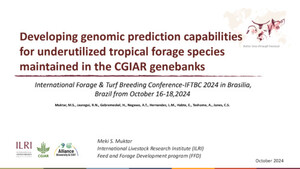
Variations in seed and post-harvest residue yields and residues quality of common bean (Phaseolus vulgaris L.) as a ruminant feedstuff
Abstract
Common bean is widely grown as a food legume and the post-harvest crop residues (CR) (i.e. haulm + pod wall (HPW)) are valuable as ruminant feedstuffs. The yields and constituents indicative of nutritive value for ruminants of the HPW from a wide range of common bean genotypes (G) were examined at 4 trial sites in Ethiopia during the 2013 main cropping season to assess the extent of genetic variation among G for simultaneous improvement of both HPW attributes and seed yield. Attributes measured were seed and HPW yields and the amounts of the morphological components, their concentrations of total nitrogen (N), neutral detergent fibre (aNDFom) and acid detergent fibre (ADFom), and the dry matter digestibility (DMD). The constituents were measured using near infrared spectroscopy (NIRS) and calibrations based on a large set of reference tropical forages and CR (including common bean), and were validated against other CR reference samples. These CR quality attributes were very well predicted with R2v and RPDv ranging from 0.90 to 0.98 and 3.13–7.36, respectively. There was considerable variation in yields of HPW and seed, and in the proportions and attributes of the HPW fractions among the common bean G. Trial site means for yields of HPW and seed ranged from 0.74 to 2.54 t/ha and 0.79–2.62 t/ha, respectively while for N, aNDFom and ADFom concentrations and DMD of HPW ranged from 7.7 to 11.4 g/kg DM, 648–739 g/kg DM, 502–585 g/kg DM, and 467–570 g/kg DM, respectively. Environment (E), as represented by site, generally affected the yields of HPW and seed (P < 0.001) and nutritive value of the HPW fractions (P < 0.05) as feedstuffs. Seed yield was positively correlated with HPW yield both within and across trial sites (r = 0.92; P < 0.0001), but in general seed yield was not related to the N concentration. Across all sites, seed yield was positively correlated (r = 0.68; P < 0.0001) with haulm DMD. Although this correlation may be due to variation associated with E rather than G, it is nevertheless important in that selection for higher seed yield is likely to also increase metabolisable energy (ME) content of the HPW. There were G x E interaction effects on yields of HPW (P < 0.0001) and seed (P = 0.011), but these were generally less important than E effects which explained 52–58% of the variation. In conclusion the study demonstrated that it is possible to identify genotypes such as ECAB0081 which combine high yields of both seed and HPW, and with HPW attributes which improve their quality as ruminant feedstuffs.
Citation
Dejene, M., Dixon, R.M., Duncan, A.J., Wolde-meskel, E., Walsh, K.B. and McNeill, D. 2018. Variations in seed and post-harvest residue yields and residues quality of common bean (Phaseolus vulgaris L.) as a ruminant feedstuff. Animal Feed Science and Technology 244:42-55.









